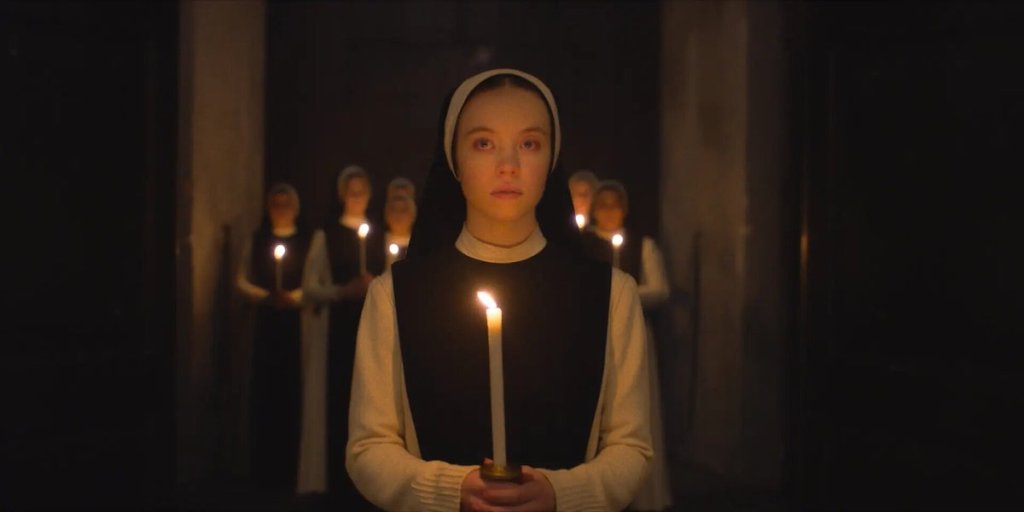
At the start of “Immaculate,” a young nun, Sister Mary (Simona Tabasco) sneaks into the Mother Superior’s bedroom late at night to look for a key.
From the way Mary furiously prays before beginning her search, to the way the keys scrape loudly against the bottom of the drawer in the otherwise silent room, this moment primes us to believe Mary is about to do something illicit, about to break a rule of some kind, maybe go to a part of the convent that’s off limits. Our suspicion is not far off – she is trying to go somewhere she’s not allowed. And that place is outside the convent walls.
Mary’s escape attempt immediately sets the tone for director Michael Mohan’s nunsploitation horror film, written by Andrew Lobel and starring Sydney Sweeney as a young woman who joins the secluded Italian convent that Mary has just risked life and limb to leave. Catholic-based horror is nothing new, with the devil often playing the essential antagonistic role. “Immaculate,” however, is not so much interested in the ways that the devil himself might infiltrate the church, but rather the evils that come from within the church’s own ranks.
Sweeney stars as Cecilia, a young nun invited by the charismatic and handsome Father Tedeschi (Álvaro Morte) to join the convent, where the younger sisters tend to older nuns in their last days. Cecilia, mild mannered and polite, notices oddities right away – including cross-shaped scars on the bottom of a fellow nun’s feet and women running around in red cloth masks – but mostly keeps any worries to herself. Until she finds out that, despite the fact that she’s a virgin, she is pregnant.
The first two acts of “Immaculate” unravel at a bit of a lulled pace, less interested in scaring and more interested in unmooring the audience as the events at this particular convent become increasingly less easy to explain away. The underlying horror here, however, is a lot more unsettling than scary nuns. Like “Rosemary’s Baby,” it’s obvious influence and somewhat inverse, “Immaculate” is the story of a woman’s body co-opted for something beyond her control. And as the third act rises to the level of that feeling of fervor and terror, Mohan’s talent as a director and Sweeney’s talent as a scream queen hit wild heights.
With all the talk of immaculate conception in the Bible, you never really hear anyone talk about how isolating it must have been for Mary to be told she was carrying the son of God. But after the revelation of Cecilia’s pregnancy, Mohan takes care to show us just how very alone she is. When the pregnancy is announced to the rest of the convent, Cecilia is hailed as sacred, forced on a pedestal dressed as the Virgin Mary, tears running down her face as two sisters unravel her cloak and leave her to stand by herself – with the exception of the two priests flanking her from either side, more foes than friends.
The patriarchal critique of Christianity in “Immaculate” is present in both subtle (and delightfully not so subtle) ways. Cecilia is subjected to everyday horrors as well as extraordinary ones. After one of the other nuns tries to drown her, screeching that it “should have been her” as she’s dragged away, a doctor and priest tell Cecilia that her baby is okay, their voices full of relief. With a look of consternation, Cecilia – who still has dark bruises around her neck from the attack – forces out the words, “But, I’m not okay,” reminding her would-be caretakers there is another life at stake here.
This is one of the first times we see sweet, kind Cecilia begin to fight back. “The meek shall inherit the earth” is something we hear frequently throughout the film, and Cecilia’s doe-eyed quality is ostensibly one of the reasons she was chosen by God – or someone playing God – to bring the so-called savior into the world. The one friend she makes, Sister Gwen (Benedetta Porcaroli) is much too brash, too distrustful of the structures around her, to make a good candidate. When Cecilia asks her if she believes in God, Gwen responds with: “Life is so cruel. Only a man can be responsible.”
It’s Gwen who inadvertently spurs Cecilia into action, full speed ahead into the film’s third act. “Immaculate,” for the most part, doesn’t depend on jump scares. Its most chilling elements – like a body falling from a balcony or a pair of scissors slowly creeping up behind a sleeping form – play out almost leisurely in the background. This halting quality creates a sense of foreboding, but a third act chase through the catacombs really captures just how unnecessary it is to startle your audience into submission. Barring one memorable moment, the catacombs chase is all long hallways and flickering light, emphasizing Cecilia’s fear of what she can’t see lurking in the shadows. One shot shrouds Cecilia in complete darkness, only her breathing audible before her pursuer’s flashlight slowly starts to bring her profile into focus, the nearing source of light more terrifying than a jump scare could be.
As the filmmaking in the third act crescendos to a high, so does Sweeney’s ascent into full on final girl mode, pregnant edition. She spends the last act waddling and limping her way to freedom, trying to escape from her literal prison and the metaphorical one her body has been transformed into. She screams, groans and sobs her way through her jailbreak, snarling and spitting through tears, gnashing her teeth as she becomes something more feral, more laced with adrenaline. The ending of “Immaculate” will no doubt be discussed and interpreted at length, but no matter what you take from it, it’s impossible not to see a woman furiously wrenching back control of her body from the monstrous structures that have taken it away.
